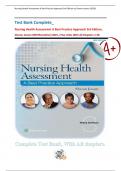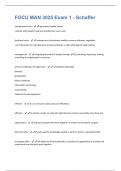Nursing Health Assessment A Best Practice Approach 3rd Edition by Sharon Jensen (2019)
Test Bank Complete_
Nursing Health Assessment A Best Practice Approach 3rd Edition,
Sharon Jensen MN RN (Author) 2019, |Five Units With All Chapters 1-30
3RD EDITION
,Nursing Health Assessment A Best Practice Approach 3rd Edition by Sharon Jensen (2019)
TABLE OF CONTENTS
UNIT 1; FOUNDATIONS OF NURSING HEALTH ASSESSMENT _________________________ 4
Chapter 01: The Nurse’s Role In Health Assessment ___________________________________ 4
Chapter 02: The Health History And Interview _______________________________________ 16
Chapter 03: Techniques Of Assessment And Safety ___________________________________ 50
Chapter 04: Documentation And Interprofessional Communication _____________________ 68
UNIT 2; GENERAL EXAMINATIONS_____________________________________________ 74
Chapter 05: Vital Signs And General Survey _________________________________________ 74
Chapter 06: Pain Assessment _____________________________________________________ 96
Chapter 07: Nutrition Assessment ________________________________________________ 104
Chapter 08: Assessment Of Developmental Stages __________________________________ 117
Chapter 09: Mental Health, Violence, And Drug Abuse _______________________________ 125
Chapter 10: Cultural Assessment _________________________________________________ 156
UNIT 3; REGIONAL EXAMINATIONS ___________________________________________ 171
Chapter 11: Skin, Hair, And Nails assessment _______________________________________ 171
Chapter 12: Head And Neck, With Vision And Hearing Basics __________________________ 192
Chapter 13: Eye Assessment For Advanced And Specialty Practice ______________________ 209
Chapter 14: Ear Assessment For Advanced And Specialty Practice ______________________ 225
Chapter 15: Nose sinuses, Mouth, And Throat ______________________________________ 242
Chapter 16: Thorax And Lung Assessment _________________________________________ 260
Chapter 17: Heart And Neck Vessels Assessment ____________________________________ 278
Chapter 18: Peripheral Vascular And Lymphatic Assessment __________________________ 295
Chapter 19: Breasts And Axillae Assessment _______________________________________ 311
Chapter 20: Abdomen Assessment _______________________________________________ 330
Chapter 21: Musculoskeletal Assessment __________________________________________ 344
Chapter 22: Neurological And Mental Status _______________________________________ 364
Chapter 23: Male Genitalia And Rectal Assessment __________________________________ 388
Chapter 24: Female Genitalia And Rectal Assessment ________________________________ 415
UNIT 4; SPECIAL POPULATIONS AND FOCI _____________________________________ 435
,Nursing Health Assessment A Best Practice Approach 3rd Edition by Sharon Jensen (2019)
Chapter 25: Pregnant Woman ___________________________________________________ 435
Chapter 26: Newborns And Infants _______________________________________________ 448
Chapter 27: Children And Adolescents ____________________________________________ 450
Chapter 28: Older Adult ________________________________________________________ 456
UNIT 5; PUTTING IT ALL TOGETHER ___________________________________________ 462
Chapter 29: Assessment Of The Hospitalized Adult __________________________________ 462
Chapter 30: Head-To-Toe Assessment Of The Adult __________________________________ 467
,Nursing Health Assessment A Best Practice Approach 3rd Edition by Sharon Jensen (2019)
UNIT 1; FOUNDATIONS OF NURSING HEALTH ASSESSMENT
Chapter 01: The Nurse’s Role In Health Assessment
Nursing Health Assessment A Best Practice Approach 3rd Edition by Sharon Jensen
MULTIPLE CHOICE
1. After Completing An Initial Assessment Of A Patient, The Nurse Has Charted That
His Respirations Are Eupneic And His Pulse Is 58 Beats Per Minute. What Type Of
Assessment Data Is This?
A. Objective
B. Reflective
C. Subjective
D. Introspective
ANS: A
Objective Data Is What The Health Professional Observes By Inspecting, Percussing,
Palpating, And Auscultating During The Physical Examination. Subjective Data Is
What The Person Says About Him Or Herself During History Taking. The Terms
Reflective And Introspective Are Not Used To Describe Data.
DIF: Cognitive Level: Understanding (Comprehension)
MSC: Client Needs: Safe And Effective Care Environment: Management Of Care
2. A Patient Tells The Nurse That He Is Very Nervous, Nauseous, And “Feels Hot.”
What Type Of Assessment Data Is This?
A. Objective
B. Reflective
C. Subjective
D. Introspective
ANS: C
Subjective Data Is What The Person Says About Him Or Herself During History
Taking. Objective Data Is What The Health Professional Observes By Inspecting,
Percussing, Palpating, And Auscultating During The Physical Examination. The
Terms Reflective And Introspective Are Not Used To Describe Data.
DIF: Cognitive Level: Understanding (Comprehension)
MSC: Client Needs: Safe And Effective Care Environment: Management Of Care
3. The Patient’s Record, Laboratory Studies, Objective Data, And Subjective Data
Combine To Form?
A. Database
B. Admitting Data
, Nursing Health Assessment A Best Practice Approach 3rd Edition by Sharon Jensen (2019)
C. Financial Statement
D. Discharge Summary
ANS: A
Together With The Patient’s Record And Laboratory Studies, The Objective And
Subjective Data Form The Database. The Other Items Are Not Part Of The Patient’s
Record, Laboratory Studies, Or Data.
DIF: Cognitive Level: Remembering (Knowledge)
MSC: Client Needs: Safe And Effective Care Environment: Management Of Care
4. When Listening To A Patient’s Breath Sounds, The Nurse Is Unsure Of A Sound
That Is Heard. Which Action Should The Nurse Take Next?
A. Notify The Patient’s Physician.
B. Document The Sound Exactly As It Was Heard.
C. Validate The Data By Asking Another Nurse To Listen To The Breath
Sounds.
D. Assess Again In 20 Minutes To Note Whether The Sound Is Still Present.
ANS: C
When Unsure Of A Sound Heard While Listening To A Patient’s Breath Sounds, The
Nurse Validates The Data To Ensure Accuracy By Either Repeating The Assessment
Themselves Or Asking Another Nurse To Assess The Breath Sounds. If The Nurse
Has Less Experience Analyzing Breath Sounds, Then He Or She Should Ask An
Expert To Listen. When Unsure Of A Sound Heard While Listening To A Patient’s
Breath Sounds, The Nurse Should Validate The Data Before Documenting To Ensure
Accuracy And Before Notifying The Patient’s Physician. To Validate That Data, The
Nurse Either Repeats The Assessment Himself Or Herself Or Asks Another Nurse To
Assess The Breath Sounds.
DIF: Cognitive Level: Analyzing (Analysis)
MSC: Client Needs: Safe And Effective Care Environment: Management Of Care
5. The Nurse Is Conducting A Class For New Graduate Nurses. While Teaching The
Class, What Should The Nurse Keep In Mind Regarding What Novice Nurses,
Without A Background Of Skills And Experience From Which To Draw Upon, Are
More Likely To Base Their Decisions On?
A. Intuition
B. A Set Of Rules
C. Articles In Journals
D. Advice From Supervisors
ANS: B
Novice Nurses Operate From A Set Of Defined, Structured Rules To Make Decisions.
It Takes Time, Perhaps A Few Years, In Similar Clinical Situations To Achieve
Competency And It Is Functioning At The Level Of An Expert Practitioner When
Intuition Is Included In Making Clinical Decisions. Intuition Is Included In Decision
Making When Functioning At The Level Of An Expert Practitioner. While





